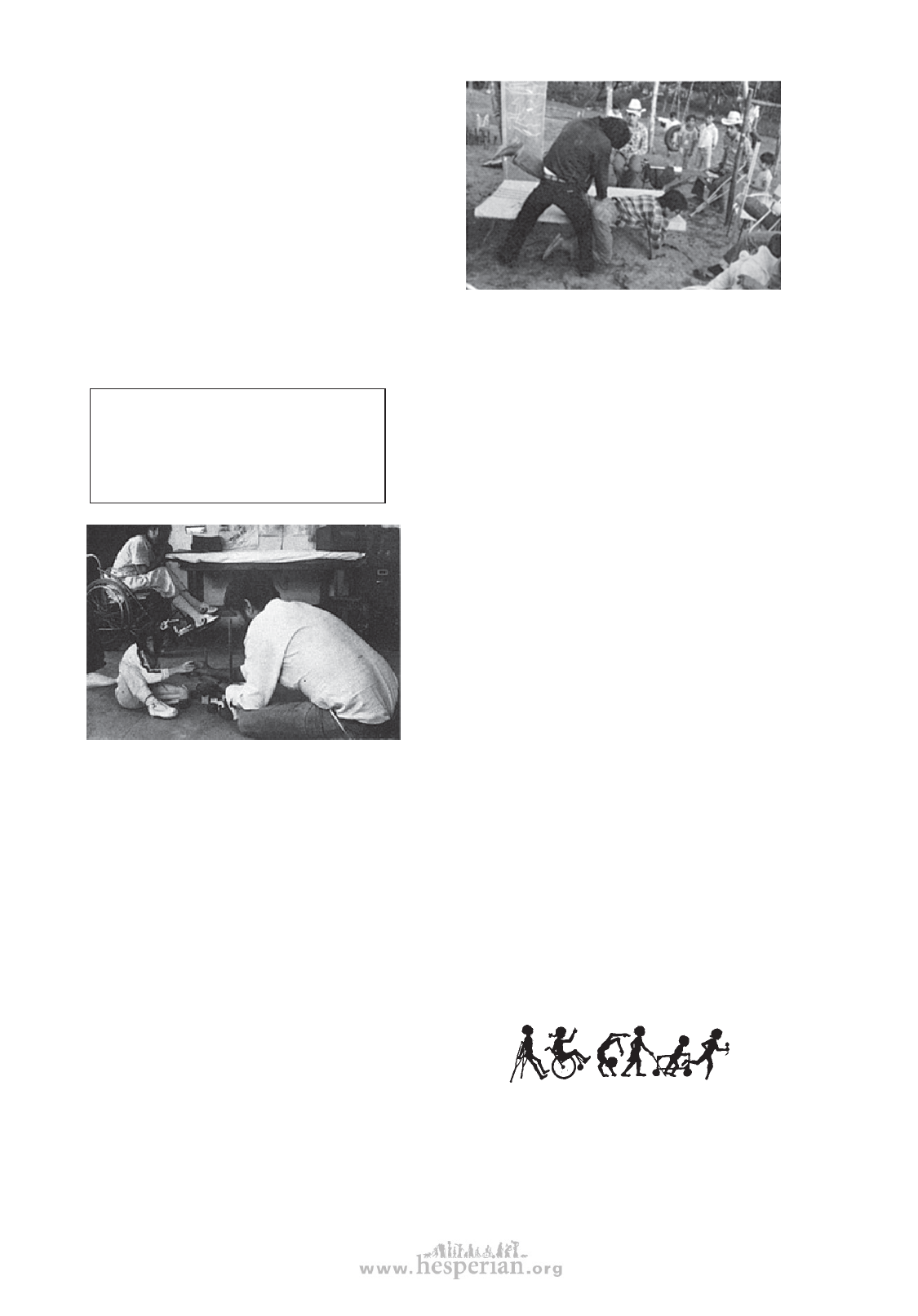
516 chapter 55
PROJIMO DIFFERS FROM MANY
REHABILITATION PROGRAMS IN
A NUMBER OF WAYS:
1. Community control. Unlike many
‘community-based’ programs, which are
designed and run by outsiders, PROJIMO is run
and controlled by local disabled villagers.
2. De-professionalization. The village
team, although they have mastered many
‘professional’ skills, is made up of disabled
persons with an average education of 3 years of
primary school. Their training has been mostly
of the non-formal, learn-by-doing type. There
are no titled professionals on the PROJIMO staff.
However, therapists, brace makers, limb makers,
and other professionals are invited for short
visits to teach rather than to practice their skills.
The PROJIMO team believes that only by
simplifying rehabilitation knowledge and
skills to make them widely available in the
community, can the millions of unserved
disabled children in the world receive the
basic assistance they need.
Roberto Fajardo and Mari Picos, two of the leaders
of PROJIMO, evaluate a child’s developmental
level. Both Roberto and Mari first came for
rehabilitation, then stayed in order to help others.
3. Equality between service providers and
receivers. When asked how many ‘workers’ they
have, the PROJIMO team has no easy answer.
This is because there is no clear line between
those who provide services and those who
receive them. Visiting disabled young persons
and their families are invited to help in whatever
way they can. Most of the PROJIMO workers
first came for rehabilitation themselves. They
began to help in different ways, decided to stay,
and gradually became team members.
4. Self-government through group process.
The PROJIMO team has been trying to develop
an approach to planning, organization, and
decision-making in which all participants take
part. They are trying to free themselves from
the typical ‘boss-servant’ work relationship and
form more of a ‘work partnership’. The group
elects its ‘coordinators’ on a one-month rotating
basis so that everyone has a turn. This leads to a
lot of inefficiency and confusion, but to a much
more democratic group process. (See p. 478.)
Disabled village Children
Most of the training of the PROJIMO team
members is through guided ‘learning by
doing’. Here, PROJIMO workers practice
exercises under the guidance of a visiting
physiotherapist. Parents, children, and
anyone who wants to learn are welcome.
5. Modest earnings. The PROJIMO team
believes that they should work for the same
low pay as that of the farming and laboring
families they serve. They see that the high pay
demanded by professionals and technicians is
one reason that the children of the poor often
cannot get the therapy and aids they need.
6. Unity with all who are marginalized. The
PROJIMO team sees society’s unfair attitudes
toward the disabled as only one aspect of an
unjust social structure. They feel that disabled
persons should join in solidarity with all who
are rejected, misjudged, exploited, or not
treated as equals. This feeling has led the team
to become more self-critical and to seek greater
equality for women within their own group.
Thus the PROJIMO team views its role not
only as one of helping disabled children and
their families gain power, but as part of the
larger struggle for social change and liberation
of all who are ‘on the bottom’.
7. Grassroots multiplying effect. The
PROJIMO approach has been spreading in
various ways. Locally, families of disabled
children in a number of towns and villages
have begun to organize, build playgrounds, and
form their own special education programs, as
more or less ‘satellites’ of PROJIMO. PROJIMO
has also invited visitors from rehabilitation and
community health programs in other parts of
Mexico and Latin America to visit and take
ideas back with them. Some programs have sent
disabled representatives to work and learn at
PROJIMO for several months so they can start
similar programs in their own area.
The PROJIMO experience has been the basis
for writing this book. Different examples or
descriptions from PROJIMO are discussed in
various chapters. For further references, see the
Index. A book on PROJIMO, Volver a Vivir/Return
to Life, with many beautiful photographs by
Suzanne Levine, is available from the Hesperian
Foundation (see p. 637).